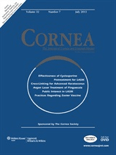
CORNEA
Scope & Guideline
Fostering excellence in the field of cornea and beyond.
Introduction
Aims and Scopes
- Corneal Surgery Techniques:
The journal covers a wide range of surgical techniques including penetrating keratoplasty, endothelial keratoplasty, and lamellar surgeries, emphasizing advancements and outcomes of these procedures. - Ocular Surface Disease and Disorders:
Research on ocular surface diseases such as dry eye disease, ocular surface squamous neoplasia, and keratoconus, focusing on their diagnosis, management, and innovative treatment strategies. - Infectious Keratitis and Microbial Pathogens:
The journal publishes studies related to infectious keratitis, exploring the microbiological spectrum, treatment outcomes, and novel therapeutic approaches for managing infections. - Corneal Biomechanics and Imaging:
A focus on advancements in corneal imaging technologies and biomechanical assessments, aiding in better diagnosis and management of corneal conditions. - Regenerative and Novel Therapies:
Emphasis on regenerative medicine approaches and novel therapeutic strategies, including stem cell therapies and the use of biomaterials in corneal repair.
Trending and Emerging
- Artificial Intelligence in Ophthalmology:
There is a growing trend towards integrating artificial intelligence in diagnosing and managing corneal diseases, highlighting the potential for enhanced accuracy and efficiency in clinical practice. - Telemedicine and Remote Assessments:
The COVID-19 pandemic has accelerated the adoption of telemedicine, with increasing publications on remote assessments for corneal conditions and the management of ocular diseases. - Innovative Therapeutic Approaches:
An increase in research focused on novel therapeutic agents such as topical nerve growth factors and biologics for treating corneal diseases indicates a shift towards personalized medicine. - Collagen Cross-Linking Techniques:
The development and refinement of corneal collagen cross-linking techniques for treating keratoconus and other corneal ectatic disorders are gaining momentum, reflecting advancements in non-invasive treatment options. - Patient-Reported Outcomes and Quality of Life Studies:
There is a rising emphasis on studies that assess patient-reported outcomes and quality of life in relation to corneal diseases, recognizing the importance of patient perspectives in treatment efficacy.
Declining or Waning
- Traditional Penetrating Keratoplasty:
The frequency of publications focusing solely on traditional penetrating keratoplasty has decreased, likely due to the rise of newer techniques like Descemet membrane endothelial keratoplasty (DMEK) that offer better outcomes. - Basic Corneal Anatomy Studies:
Research centered on basic corneal anatomy and histology seems to be declining, as the field shifts towards more clinical applications and translational research. - Static Imaging Techniques:
There is a noticeable decline in studies utilizing traditional static imaging techniques, with a shift towards dynamic imaging methods such as optical coherence tomography (OCT) that provide more functional insights. - Epidemiological Studies Without Clinical Application:
Epidemiological studies that do not directly inform clinical practice or interventions appear less frequently, indicating a preference for research that can translate into actionable clinical strategies.
Similar Journals

GRAEFES ARCHIVE FOR CLINICAL AND EXPERIMENTAL OPHTHALMOLOGY
Fostering Excellence in Ophthalmic ResearchGRAEFES ARCHIVE FOR CLINICAL AND EXPERIMENTAL OPHTHALMOLOGY, published by Springer, has established itself as a premier journal in the field of ophthalmology since its inception in 1870. With an ISSN of 0721-832X and an E-ISSN of 1435-702X, this esteemed journal enjoys a notable impact in the research community, ranking Q1 in Ophthalmology and Q1 in Sensory Systems, as per the latest 2023 journal category quartiles. GRAEFES Archive is dedicated to advancing our understanding of ocular health through both clinical and experimental studies, making it an essential resource for researchers, practitioners, and students alike. Its comprehensive scope covers various aspects of ophthalmic science, reflecting its long-standing commitment to quality and excellence. Although it currently operates on a subscription basis, the journal's significant Scopus rankings—24th out of 137 in Ophthalmology—underscore its relevance and influence within the scientific community. Situated in Germany, with its address in the United States, this international journal continues to shape the discourse on vision science and therapeutic innovation.

INTERNATIONAL OPHTHALMOLOGY
Exploring New Frontiers in Eye Research.International Ophthalmology is a prestigious journal published by Springer, dedicated to advancing the field of ophthalmology through the dissemination of high-quality research and clinical studies. With an ISSN of 0165-5701 and an E-ISSN of 1573-2630, this journal has been a vital resource since its inception in 1978, serving the global community of ophthalmologists, researchers, and healthcare professionals. The journal holds a significant Q2 ranking in the category of ophthalmology and has achieved a commendable position as #56 in Scopus's rankings, placing it within the top tier of its field. Although it does not offer open-access options, articles published in International Ophthalmology are widely cited and respected, playing a crucial role in the ongoing dialogue regarding contemporary ophthalmic practices and innovations. With a broad scope covering all aspects of eye care, this journal is essential for those aiming to keep abreast of the latest developments and research findings that shape the future of vision science and clinical practice.
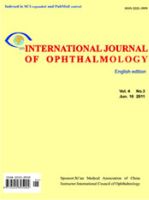
International Journal of Ophthalmology
Bridging Research and Practice in Eye HealthThe International Journal of Ophthalmology, with ISSN 2222-3959 and E-ISSN 2227-4898, is a premier open-access publication dedicated to advancing the field of ophthalmology. Published by IJO PRESS in China, this journal has been a valuable resource since its inception in 2005, providing a platform for groundbreaking research and clinical studies in ophthalmic science. With an impressive Q2 ranking in the 2023 Ophthalmology category and a Scopus rank of #65 out of 137, the journal consistently showcases high-quality articles that contribute significantly to the understanding and treatment of eye diseases. Since adopting an open-access model in 2010, it has expanded its reach, allowing researchers, professionals, and students worldwide to access vital knowledge in the field. The journal aims to bridge the gap between laboratory research and clinical practice, making it an essential resource for those committed to improving visual health and advancing ophthalmologic education and innovation.
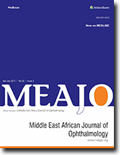
Middle East African Journal of Ophthalmology
Elevating eye care standards across the Middle East and Africa.The Middle East African Journal of Ophthalmology is a distinguished publication dedicated to advancing knowledge in the field of ophthalmology, published by Wolters Kluwer Medknow Publications in India. With a robust focus on contributions that bridge the gap between clinical practices and scientific research, this journal serves as a crucial platform for researchers, practitioners, and students alike. Since its inception, it has consistently disseminated high-impact research, achieving notable recognition with a Q3 ranking in both Medicine (miscellaneous) and Ophthalmology categories as of 2023. Despite being a newer entrant into the scholarly landscape, it features an array of innovative articles, highlighting significant advancements and emerging trends in ocular health. Researchers may access a wealth of knowledge through its open access articles, promoting the dissemination of vital ophthalmic research that is relevant in both Middle Eastern and African contexts. By fostering collaboration and communication among professionals in the field, the Middle East African Journal of Ophthalmology is committed to championing excellence in eye care and elevating the standard of research applicable to global populations.
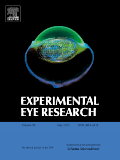
EXPERIMENTAL EYE RESEARCH
Exploring the Frontiers of Visual MechanismsEXPERIMENTAL EYE RESEARCH, published by Academic Press Ltd - Elsevier Science Ltd, is a preeminent journal dedicated to advancing the fields of ophthalmology and neuroscience. With a history of insightful publications dating back to 1961, this journal serves as a critical platform for researchers, professionals, and students interested in the cellular and molecular mechanisms underlying visual processes. The journal boasts impressive rankings, including being placed in the top quartile (Q1) of both the Ophthalmology and Sensory Systems categories, and is recognized in the 2nd quartile (Q2) for Cellular and Molecular Neuroscience. With an impact factor reflecting its significant contribution to the field, EXPERIMENTAL EYE RESEARCH is a valuable resource that promotes the exchange of innovative research and ideas essential for understanding the complexities of eye function and vision-related disorders. Researchers looking to publish their findings or stay abreast of the latest studies will find this journal a vital component of their academic toolkit.
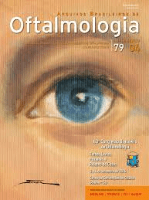
ARQUIVOS BRASILEIROS DE OFTALMOLOGIA
Pioneering open access to vital ophthalmology insights.ARQUIVOS BRASILEIROS DE OFTALMOLOGIA is a prominent peer-reviewed journal dedicated to the field of ophthalmology, published by CONSEL BRASIL OFTALMOLOGIA since its inception in 1945. With its commitment to disseminating high-quality research, the journal has transitioned to an Open Access model since 2001, ensuring that vital findings in ophthalmology are freely available to researchers, clinicians, and students alike. Located in São Paulo, Brazil, this esteemed publication occupies a significant position in the medical field, currently holding a Q3 ranking in both the miscellaneous medicine and ophthalmology categories. Although it maintains a legacy of fluctuating impact, recognized for its contribution to the academic community, ARQUIVOS BRASILEIROS DE OFTALMOLOGIA continues to attract a diverse international readership, making it a valuable resource for advancements in eye health, surgical techniques, and ocular research.
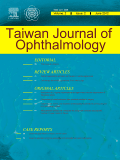
Taiwan Journal of Ophthalmology
Fostering global collaboration for better vision outcomes.Taiwan Journal of Ophthalmology is a premier open-access publication dedicated to advancing the field of ophthalmology. Published by Wolters Kluwer Medknow Publications, this journal has been a vital resource for researchers, practitioners, and students since its inception in 2012. With an ISSN of 2211-5056 and an E-ISSN of 2211-5072, it provides a platform for sharing innovative research, clinical findings, and reviews pertinent to eye health and vision science. The journal is indexed in Scopus and currently holds a Q3 quartile ranking within the ophthalmology category, reflecting its commitment to quality and relevance in the medical community. Located in Mumbai, India, Taiwans Journal of Ophthalmology aims to foster discussions and disseminate knowledge that promotes better understanding and treatment of ocular diseases, ensuring that the latest advancements reach a global audience. By embracing open-access policies, the journal underscores its dedication to making valuable insights readily available to all interested parties, thus contributing significantly to the discourse in ophthalmic research.

Journal of Ophthalmic & Vision Research
Advancing the Frontiers of Eye CareThe Journal of Ophthalmic & Vision Research, published by KNOWLEDGE E, stands as a crucial platform for disseminating high-quality research in the field of ophthalmology. With an ISSN of 2008-2010 and an E-ISSN of 2008-322X, this journal fosters open access to valuable insights since 2010, enhancing visibility and reach for researchers globally. Based in Dubai, UAE, it has established a reputation for excellence, reflected in its Q2 ranking in Ophthalmology for 2023 and its position among the top 65th percentile in Scopus. Covering a broad spectrum of topics within ophthalmic science, the journal serves as a vital resource for professionals, researchers, and students by presenting original research, reviews, and case studies that drive innovation and collaboration within the community. As the journal continues to contribute to advancements in eye care and vision sciences, it invites scholars to explore, engage, and publish within its pages, thus enriching the global discourse on ophthalmic health.

Spektrum der Augenheilkunde
Bridging Knowledge Gaps in OphthalmologyWelcome to Spektrum der Augenheilkunde, a distinguished journal published by SPRINGER WIEN, dedicated to the field of ophthalmology since its inception in 1987. With an ISSN of 0930-4282 and an E-ISSN of 1613-7523, this journal is recognized for its commitment to publishing original research, reviews, and clinical studies that address current and emerging topics in eye health and treatment. Although classified in the Q4 category for ophthalmology as per the latest 2023 rankings, it serves as a valuable platform for researchers, professionals, and students looking to contribute to and expand their knowledge in this vital area of medicine. Based in Austria and accessible through various academic databases, the journal aims to foster communication among professionals and advance the understanding of ocular diseases, innovative therapies, and clinical best practices.

JOURNAL OF OCULAR PHARMACOLOGY AND THERAPEUTICS
Empowering research to enhance eye disease treatments.JOURNAL OF OCULAR PHARMACOLOGY AND THERAPEUTICS, published by Mary Ann Liebert, Inc, stands at the forefront of research in the realms of ophthalmology and pharmacology. Established in 1985 and converging until 2024, this esteemed journal is dedicated to advancing the understanding of ocular pharmacology, drug therapies, and therapeutic approaches in the treatment of eye diseases. With an impressive impact factor and categorized in the Q2 quartile for both Ophthalmology and Medical Pharmacology, it showcases pivotal research in the field, reflecting its rank of #31 among 137 in Ophthalmology and #109 among 272 in Medical Pharmacology per Scopus metrics. Although it follows a subscription-based model, the journal provides critical insights and empirical studies that foster innovation and collaboration for researchers, professionals, and students alike in the pursuit of improving ocular health.